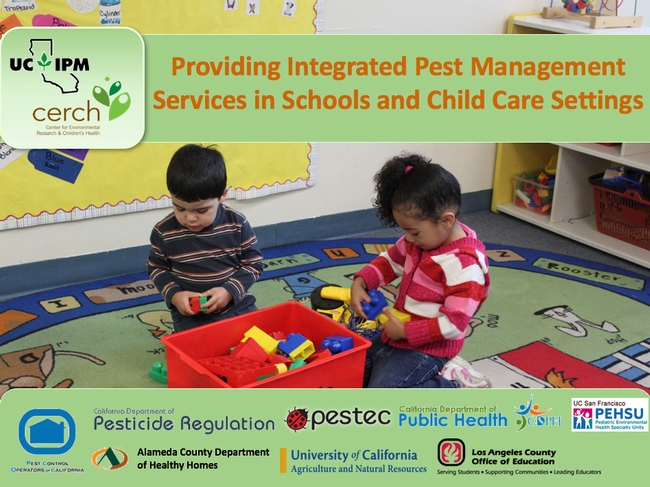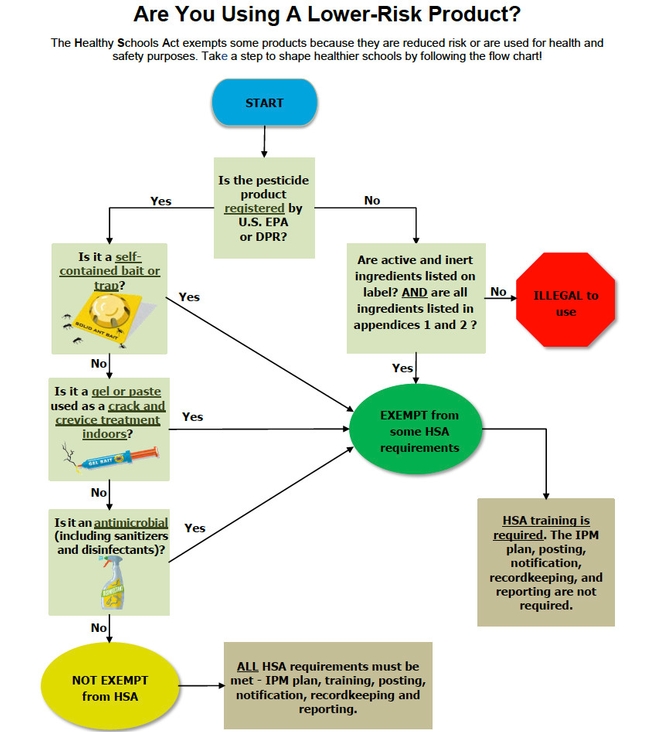
While students and teachers were enjoying summer break, an amendment to the Healthy Schools Act (HSA) went into effect on July 1. It requires teachers, custodians, administrators, other staff or volunteers, and licensed pest management professionals applying any pesticide (this includes disinfectants and antimicrobials) at a school site to take an annual training course covering school integrated pest management (IPM). The training course must be approved by the California Department of Pesticide Regulation (DPR).
An online course, Providing Integrated Pest Management Services in Schools and Child Care Settings, developed by the UC ANR Statewide IPM Program and the Center for Environmental Research and Children's Health (CERCH), has recently been approved by DPR to satisfy the annual training requirement of the HSA. Although this course was designed for licensed pest management professionals, anyone applying any type of pesticide in schools or child care centers will benefit from the course.
IPM is a strategy that focuses on long-term prevention of pests through a combination of techniques such as monitoring for pest presence, cleaning up food sources, sealing up cracks, and excluding pests with screens. Effective pesticides that pose the least possible hazard and that minimize harm to people, property, and the environment are used only after careful monitoring indicates they are needed.
The HSA encourages the use of IPM in schools and child care centers and gives parents and the public the ability to know when and where certain pesticides are used in these facilities. It was originally signed into California law in September 2000 and is located in four different California codes: education, food and agricultural, business and professions, and health and safety. The law has been amended several times. The most recent revision to the HSA was signed into law in September 2014 by Gov. Brown.
Prior to July 1, schools were already required to do the following:
- Designate an IPM coordinator at the school or district level to make sure the requirements of the HSA are met
- Create an IPM plan
- Provide annual written notification to all parents and staff of pesticide products intended for use at the school site during the year and allow the opportunity for them to be notified before certain applications
- Post warning signs where certain pesticides are applied
- Keep records of pesticide applications
- Send pesticide use reports to DPR annually
Some pesticide products are exempt from the IPM plan, notification, posting, recordkeeping, and reporting* requirements of the HSA at school sites. These are reduced-risk pesticide products, and their use is encouraged at schools if pesticides are deemed necessary. These include:
- Self-contained baits or traps
- Gels or pastes used indoors in cracks and crevices
- Antimicrobials, including sanitizers and disinfectants
- Pesticides exempt from registration, such as food grade oils
However, these products are NOT exempt from the Healthy Schools Act annual training requirement that went into effect July 1. Anyone who uses these products—a licensed professional, school staff or child care staff—is still required to take the HSA annual training course.
To satisfy this annual training requirement, take the free UC IPM online course by visiting the UC IPM online training webpage. For more on school and child care IPM and other courses that satisfy the Healthy Schools Act training requirement, visit the DPR website.
*Licensed pest management professionals hired to apply pesticides at schools or licensed child care centers must continue to submit their regular pesticide reports of ALL registered pesticides to DPR annually and to the county monthly.
